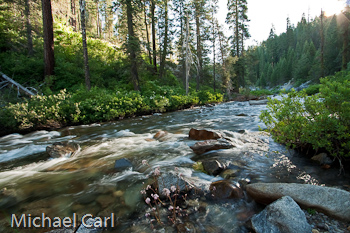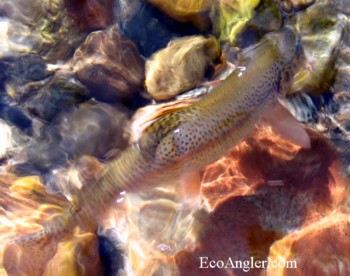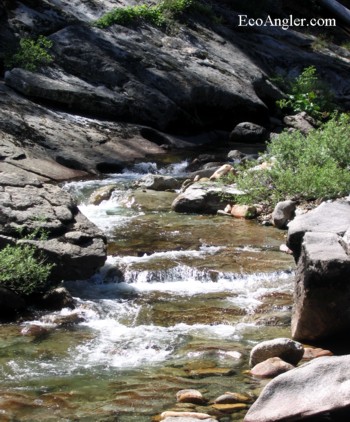Clavey River
The EcoAngler Report
Planning a trip to the Clavey River? Get scientific based angling intel in The EcoAngler Report - Clavey River.
Detailed information on the Clavey's native rainbow populations along with a map and directions to access this wild and undammed river can be purchased here.
An Adobe PDF document will be made available after your purchase. Select Return to the Ecological Angler to view and save your purchase.
The Wild and Scenic Clavey River
The Clavey River is one of the longest undammed rivers in the Sierra Nevada. The Clavey flows out of an alpine lake drainage in the Emigrant Wilderness (north of Yosemite National Park) for 47 miles to its confluence with the Tuolumne River. Boulders from the Clavey River help form the infamous class V rapid on the Tuolumne known as Clavey Falls.

The Clavey River canyon remains largely undeveloped, except for occasional road crossings. A significant portion of the Clavey flows through the Stanislaus National Forest. Typical of a National Forest, the area has an extensive network of roads to support commercial logging and open access to remote backcounty for 4-wheel drive and ATVs. Its upper tributaries, Bell Creek and Lily Creek provide trailheads into the Emigrant Wilderness. But for much of its length, people who wish to explore the wild Clavey must do so without the benefit of trails or roads. After Spring run-off has peaked, the Clavey becomes easy to wade and the river can be crossed to reach further along its length.

Clavey River - Home to Diverse and Wild Ecosystem
The Clavey is considered to be one of the most biologically and ecologically rich watersheds in the Sierra. Flowing from more then 9,000 feet in elevation to 1,200 feet, the river canyon encompasses all but one of the ecological life zones of the Sierra Nevada. The Clavey's upper canyon holds a large stand of ancient forest providing critical habitat to the California spotted owl and the Pacific fisher. Further downstream, the river flows through a rocky and brushy canyon typical of the Sierra foothills.

Ecologists often use an EPT Metric. Ephemeroptera (mayflies), Plecoptera(stoneflies), and Trichoptera (caddisflies) as indicators of stream ecosystem health. If EPT is high, the stream ecosystem is regarded to be healthy because these three orders are physiologically sensitive to degraded water quality. The Clavey River's high water quality provides suitable conditions to support a rich assemblage of EPT families. This assemblage highlights the absence of adverse human impacts that are common to other rivers, such as water diversions, agricultural and urban runoff, and sedimentation. In fact, the only significant human impacts stem from the thousands of river rafters who stop at the Clavey River confluence each summer.
The Clavey River is a healthy ecosystem, but it is not extremely productive. The river is oligotrophic; the low nutrient content offers relatively less food for aquatic insects. Therefore, the number of individuals that can be supported in its waters is limited.
The Clavey's ecosystem hosts healthy communities of aquatic insects, and of course, native rainbow trout. In recognition of the river's wild native trout, the California Department of Fish & Game has designated the Clavey a Wild Trout Stream.
Some information provided by Friends of the River. I would also like to personally thank Ned Morris for some directional help to reach the upper Clavey. (Ned, you're absolutely right about the fight in these fish.)
